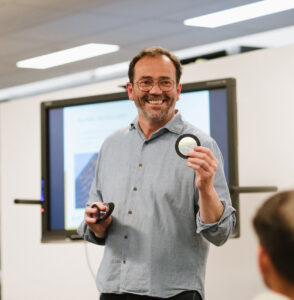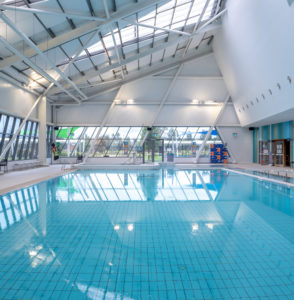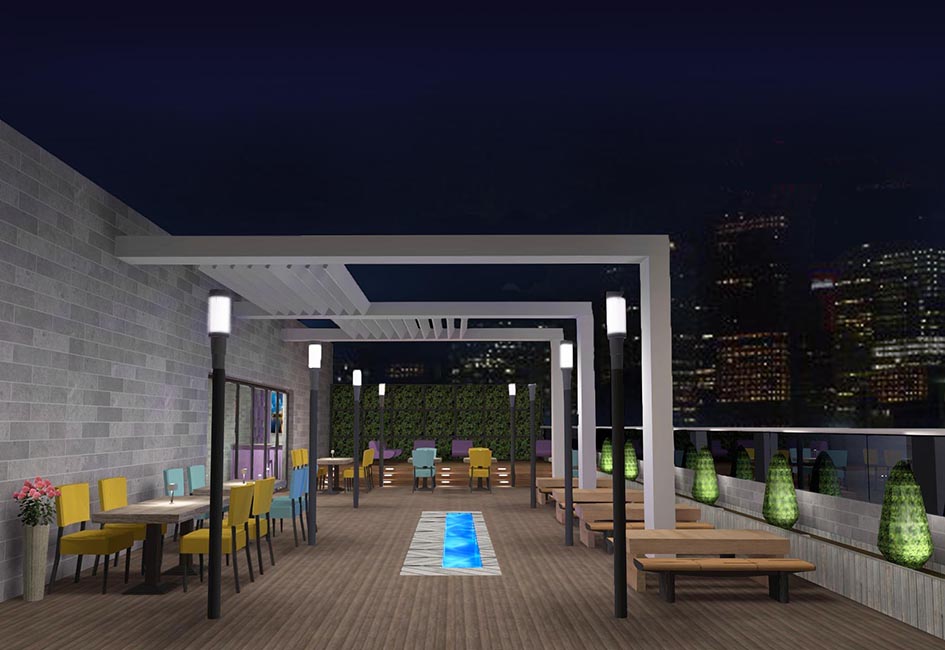
LEARN
Design Clinic: How To Light A Roof Terrace
Over half the world’s population lives in a city. Open space is at a premium and the roofs of buildings are an under-used asset…
View Article
Words by: WE-EF
They can provide a safe, private space for the building users. The air is a little bit cleaner and quieter and there isn’t the hurly burly of the street. Roofs also have great views of the city!
Maybe the best approach to designing the rooftop is to think of it as an urban courtyard. It never gets completely dark in cities due to the inevitable skyglow. This means that, apart from essential functional lighting, you can concentrate on highlighting specific features.
People often congregate in these areas and so seating and tables are essential. There is also a strong argument for having some green space, planting and foliage. Water features are relaxing and provide cool air in a hot summer city.
Although these spaces are usually private and are not part of the public realm, it may be the best option to design them as if they were. It is hard to image how a risk assessment of the lighting levels would differ much from those of an equivalent public space. As such, you can refer to legislative documents such as BS 5489 or guidance from the Society of Light and Lighting LG6 or from the Institution of Lighting Professionals.
Never forget that vertical illumination on people’s faces is as important as the horizontal at ground level. It is always a good idea to run a quick calculation showing vertical illumination at about 1.5m above ground just to check that people can see each other clearly.
Finally, always think about what the courtyard will look like by day as well as night.
Our terrace has the plan dimensions of a small building (8m x 16m).
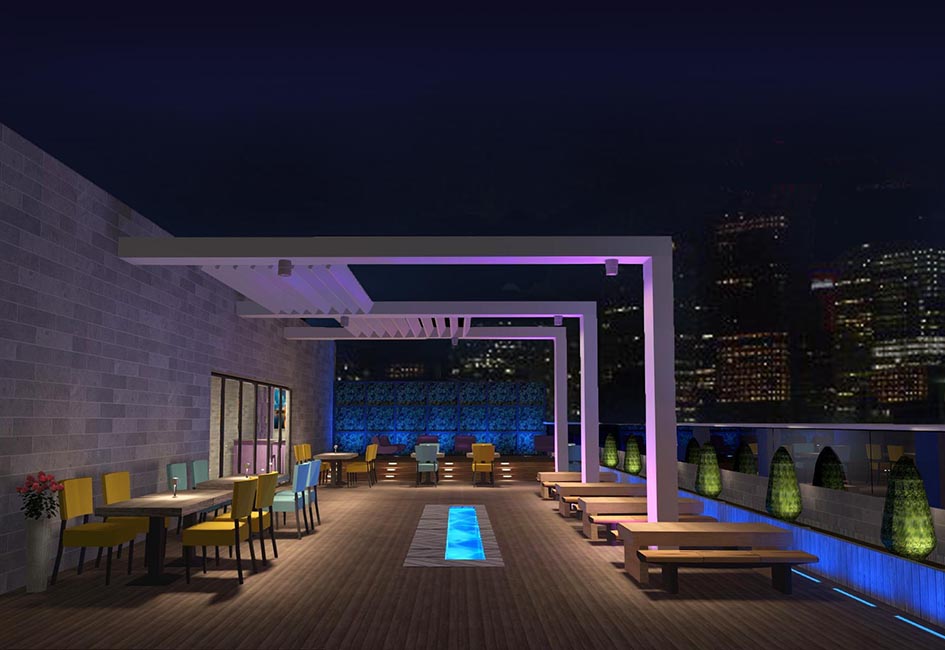
1. City Color
Colour can make a welcome change from bland corporate interiors. The trick is not to over do it. Here, we have just used two colours.
The functional, “white light” illumination comes from surface mounted DAC220 downlights mounted on the roof beams. Instead of a conventional conical beam, we have used an asymmetric version which produces diffuse bands of light along the length of the roof terrace. We have also dimmed them to balance the pattern of luminance (brightness) across the whole scene.
We have added colour in two ways. The roof beams are uplit using ground recessed ETC130 CC colour changing luminaires. The rgb LEDs are combined to produce a soft wash of colour on the vertical surface and underside of the L-shaped structure. The foliage at the end of the terrace is also illuminated with the ETC130 but this time with a single colour blue.
We have also used the linear uplighter ETV120 on the walls. This has five different optical distributions available so you can illuminate the vertical surfaces exactly as you require.
Tech Spec A
Luminaires: DAC220 and ETC130 CC. Plus STO234 steplight and linear ETV120
Optical control: CAD optimised optics and lensed LEDs
Arrangement: 5 No DAC220 surface mount and 8 No recessed ETC130 CC
Electrical load per luminaire: 12W and 19W plus 5W steplight and 15W linear
Pros: Flexible and colour changing
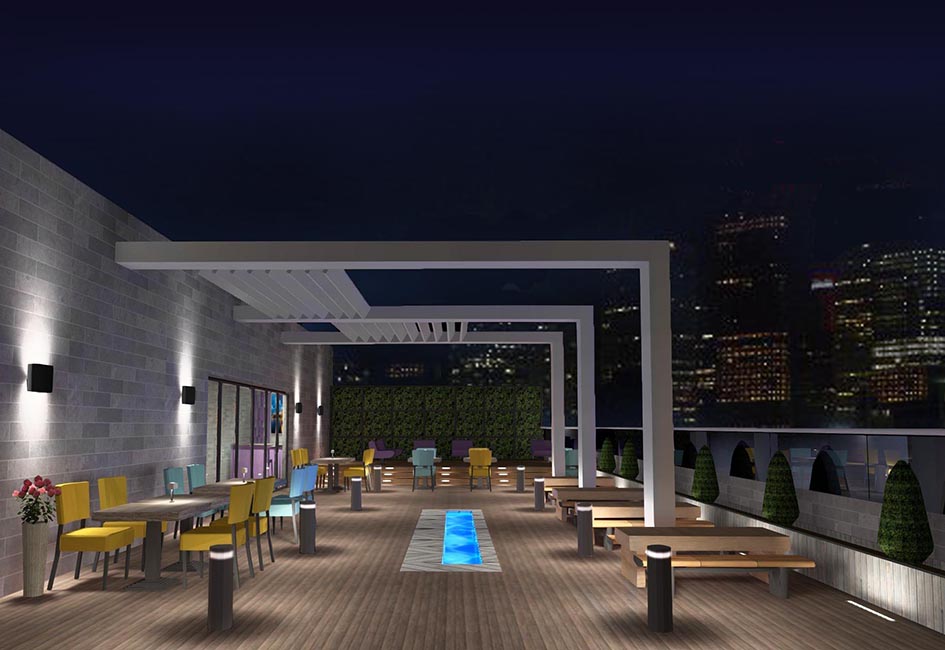
2. Relaxing
We have used a completely different approach here. The main lighting comes from 1m high KTY243 bollards and direct/indirect wall lights, QLS420.
This is a really tough bollard with a polycarbonate diffuser and an impact resistance of IK10. It provides a good level of illumination across the whole of the terrace and, being 1m high, also provides light on the low tables on the right.
The rectangular QLS420 wall light is used to provide extra illumination on the tables nearest the walls. The upward light also adds volume to the space.
There are also ETV120 linear inground uplighters used to illuminate the low wall on the right.
Tech Spec B
Luminaires: Round KTY234 bollard and square QLS420 direct/indirect wall luminaire and STO234 steplight
Optical control: CAD optimised indirect and indirect optics
Arrangement: 8 No 1m high bollard and 4 wall lights
Electrical load per luminaire: 8W, 2 x 6W, 5W steplight and 15W linear
Pros: Understated and tasteful

3. Clarity
Column mounted luminaires can be a surprisingly good way to illuminate a roof. These are quite low and are just 2.5m from the centre of the light source to the ground. As such, they are lower than the main building and roof structure and so they do not impinge on the skyline.
To add some colour to the scheme, we have used inconspicuous medium-angle FLD111 spotlights in the planters to highlight the low-level shrubs.
The big advantage of this scheme is where you want to provide good levels of illumination and uniform lighting.
Tech Spec C
Luminaires: ZFT430 and FLD111 spotlight
Optical control: CAD optics plus pmma and flat glass lens
Arrangement: 8 No ZFT430 at 2.5m mounting height plus FLD111 6W spotlight
Electrical load per luminaire: 12W and 6W
Pros: Uniform high-level lighting with a touch of colour
